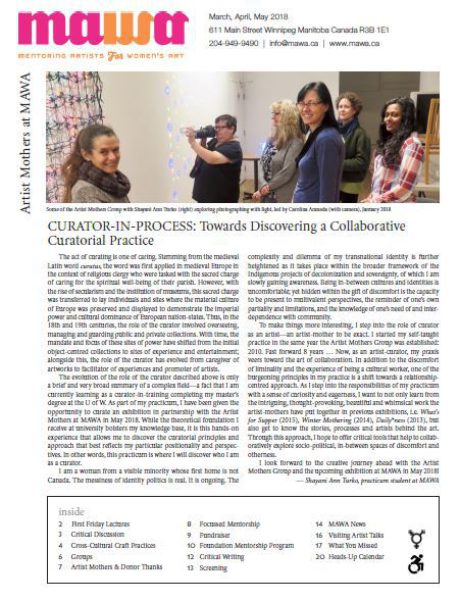
Love and kindness in every stitch: Leanna Marshall’s Zaagi’idiwin Project
by Nadia Kurd
the wind has worn my edges
the cold pricked away brittle skin
bones lying here in front of you
lost before they can begin
there’s red on the ice of the lake
there’s bruises that never heal
there’s past collapsing on present
she took things i didn’t know you could steal
- Leanne Betasamosake Simpson, excerpt from “travel to me now”
Many of the stories that have shaped Leanna Marshall’s series of nine jingle dresses in her 'Zaagi’idiwin Project' began long before she was born. These stories have roots in her Anishnawbe maternal family and her paternal English side, straddling the northern edges of Ontario to the southern borders of Alberta. These stories continue to intrinsically inform her life and are now a part of her daughters’ lives. As historian Adele Perry argues, “a serious reckoning with the past tends to point us toward the systemic, embedded character of social divisions and inequities, showing us how they are built into the fabric of our pasts and our presents.”[ii]
It was the past that came to confront Marshall in 2012, when she began to stitch together her stories and jingle dresses. Spurred by her mother’s testimony at the Truth and Reconciliation Commission in Lethbridge, Marshall began creating these jingle dresses as a means to come to terms with not only her mother’s experiences at Poplar Hill Indian Residential School in Northwestern Ontario, but also to understand the devastating circumstances that led her mother to lose custody of her three young children upon separating from their father.
The term Zaagi’idiwin means love and kindness, and it is rooted in the sacred Grandmother and Grandfather Teachings of the Anishnawbe. The teachings are used as a guiding principle to living one’s life and have provided the Anishnabeg with a holistic worldview for thousands of years. The concept of Zaagi’idiwin encapsulates a complete and total approach to love, one that affirms “to love yourself” and to “live at peace with the creator and in harmony with all creation.”[iii] For Marshall, the teaching also emphasizes that “the actions of love [are] why we are here: to make this world one that reflects us, who we are. To address the injustices with fury and with understanding so we can make choices that will [affect] the next generations to come.”[iv]
Zaagi’idiwin envelops Marshall’s creative process. The first dress Marshall designed and stitched, 'Say a Prayer to the Moon' (2013), recounts her mother’s experience of harsh discipline at Poplar Hill and how, alone at night, she prayed to the full moon to bring her father to take her home. Made of black velvet, the dark cloth represents the darkness of the night, whereas the large, yellow, beaded circle radiates light alongside the silver jingles that cover the dress. In making this piece, Marshall also enlisted the help of her twin sister, Jean Marshall, to bead the circle. This collaborative process connects her familial relations within the concept of Zaagi’idiwin, but also embodies the shared stories that have shaped their families and that, at times, have been the source of their estrangement.
Soon after creating her first dress, Marshall made others, such as 'Grandma Marshall’s Memories' (2015) in honour of her English, paternal grandmother also named Jean Marshall who was a World War II widow. During the creation of this dress, Marshall imagined the circumstances of her grandmother’s life during the 1950s. By the time she was in her 60s, Marshall’s grandmother began suffering the effects of Alzheimer’s and, as a result, was unable to communicate much to her grandchildren. Made of broadcloth and velvet, the dress is designed in the style of the period and features jingles lined on the back to signify the weight that women, particularly single mothers, carry in raising their families. The dress honours her grandmother’s life and also acknowledges the histories lost due to the degenerative effects of Alzheimer’s.
Many of Marshall’s other dresses are similarly connected to her familial history. They all honour the women in her life and, in their creation, seek to heal. Indeed, for many Anishnaabeg, the jingle dress is a healing dress. Now often worn during Pow Wows for dances, the jingle dress has deep, diverse origins in Anishnawbe oral traditions. The restorative and resonating sounds of the metal cones that cover the exterior of the dress continue to symbolize the persistence of Anishnawbe women.
Unfortunately, Canadian attitudes, current and past laws, child welfare and judicial structures continue to discriminate systematically against Indigenous women. Métis writer Chelsea Vowel points out that “historic trauma transmission,” which refers to the summative “emotional and psychological wounding across generations,” describes the ongoing and indeed, detrimental effects of Canada’s residential school history on survivors and their families.[v] The need to create and dance jingle dresses at a time when the idea of “reconciliation” is circulating in the mainstream public has much to offer. Marshall’s work provides a poignant examination of the past and offers insights into the ways in which Anishnawbe women hold stories about this place called Canada. This has lessons for all of us.
Dr. Nadia Kurd is a second-generation Kashmiri-Canadian Muslim and an interdisciplinary art historian. She is currently the curator of the Thunder Bay Art Gallery.
Leanne Betasamoske Simpson, This Accident of Being Lost (Toronto: House of Anansi Press, 2017), 47.
[ii] Adele Perry, Aqueduct: Colonialism, Resources and the Histories We Remember (Winnipeg: ARP Books, 2016), 18.
[iii] Native Women’s Centre, Traditional Teachings Handbook, 2008. (accessed November 1, 2017: http://www.nativewomenscentre.com/files/Traditional_Teachings_Booklet.pdf).
[iv] Nadia Kurd, personal communication with the Artist, December 3, 2017.
[v] Chelsea Vowel, Indigenous Writes: A Guide to First Nations, Métis & Inuit Issues in Canada (Winnipeg: Highwater Press, 2016), 172.

